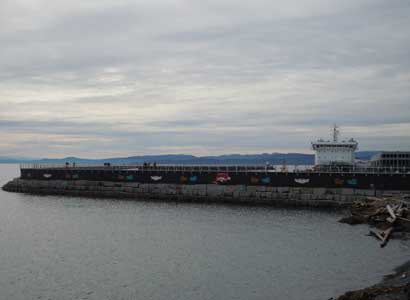Heritage Register
James Bay
187 Dallas Road
Ogden Point Breakwater & Wharves
Built
1914-17
National Historic Civil Engineering Site 2001
(not on City of Victoria Heritage Register)
For: Government of Canada
Design Engineer: Louis Coste
Supervising Engineer: J.S. Maclachlan
Chief Engineer, Public Works Canada: D. Lafleur
Contractor (breakwater): Sir John Jackson Ltd
Contractor (docks): Grant, Smith & McDonnell

Ogden Point was named for HBC chief factor Peter Skene Ogden. As BC’s first mega-project, the construction of the breakwater and docks was touted as having far-reaching benefits for Victoria.
The opening of the Panama Canal in 1914 brought the anticipation of an economic boom, with increasing marine traffic to the West Coast. Before it opened, there were two ways to reach the West Coast: an arduous trip across land, or a dangerous sail around Cape Horn. At that time Victoria was the largest seaport in Western Canada, and unlike Montreal, was not icebound for five months of the year. Unfortunately, Victoria’s harbour was relatively shallow, fraught with dangerous obstacles, and could not accommodate the anticipated increase in traffic. Marine disasters such as the 1911 sinking of the Sechelt bound for Sooke from Victoria, which resulted in 58 deaths, as well as the Iroquois, which met a similar fate with 21 well-known Victorians on a trip from Sidney to Ganges Harbour on Saltspring Island, deterred companies from using Victoria’s harbour. Several years earlier, the passenger liner Valencia ran aground off Race Rocks, and 145 lives were lost; and the sinking of the Clallam in 1904 off Trial Island killed 55.
Harry Barnard (1462 Rockland Av), the man responsible for building the Empress Hotel, was an ambitious lawyer and visionary leader. A Victoria alderman and mayor, he was later an MP, then a senator. Through his position on the Victoria Board of Trade he reached Canada’s new prime minister, Robert Borden, who commissioned engineers to examine Victoria’s waterfront and recommend a course of action.
Rithet’s Pier, where the Canadian Coast Guard Station is located today, was Victoria’s primary dock. However, it was heavily exposed to the southwesterly winds of Juan de Fuca Strait, so initially two breakwaters were recommended: a 2500 foot breakwater off Ogden Point, and a smaller one off McLoughlin Point, which would help to fully protect Victoria’s Inner Harbour.
In 1914, the British firm of Sir John Jackson was awarded the contract to build the breakwater to establish deep port facilities in Victoria. The project was completed on schedule in 1917, an incredible feat considering WWI delays. Over one million cubic yards of locally-quarried rock was dropped into deep water to support the main wall of more than 10,000 granite blocks, each weighing up to 15 tons, stacked in a pyramid in nine layers. Attesting to the ingenious engineering, the breakwater has not required any major upgrades since it was built, and only 136 blocks have ever been repositioned over the intervening years. The second breakwater was never built; contractors Grant, Smith & McDonnell were hired to build new docks instead. These were constructed from 53 concrete caissons, watertight structures used for laying foundations underwater, weighing 3000 tons each, which were built in Esquimalt Harbour, towed to Ogden Point and dropped into position. Over one million cubic yards of dredged material was then used to form the docks. The breakwater and docks cost about $5 million to build.
The shipping boom made Victoria’s harbour hum with commercial and industrial activity until the 1970s, when these activities dwindled. However, Ogden Point was built with the foresight to accommodate today’s large cruise ships, and the breakwater continues to be popular with pedestrians. In 2001 the breakwater and docks were named a National Historic Civil Engineering Site.
ADDITIONAL INFORMATION & IMAGES:
• Map of Victoria Heritage Register Properties
• James Bay History
• James Bay Heritage Register
• This Old House, Victoria's Heritage Neighbourhoods,
Volume Two: James Bay

